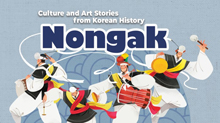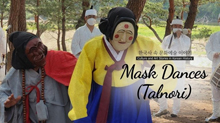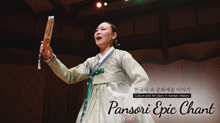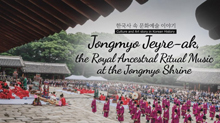The Story of Culture and Arts
- Image resource of Korean history
- Documents from History TextBooks
- Culture & Art Stories from Korean History
- Culture & Art Stories from Korean History - Korean
- National Institute of Korean History
- History net
- About the site
- Introduce
-
Numerous topics related to Korean culture and art are mentioned in middle and high school national history textbooks, but most of them are briefly described by era, making it difficult to understand their concepts, transition processes, and characteristics.
<Culture & Art Stories from Korean History> produces and provides video materials based on expert commentary on the flow, change process, characteristics and characteristics of each major topic in the field of culture and art in Korean history.

Scenario
The Dance of Cheoyong, a dance based on a famous folktale. With a beet red mask and long, flowing sleeves, this dance, which is meant to drive out the bad spirits and welcome the good, is 1,100 years old, making it Korea’s oldest court dance.
Court dances are not just a bunch of sounds and movements, but a way of demonstrating the harmony and order between Heaven and Earth. Let’s take a closer look.
Expressing Propriety through Dance – Court Dances, the Flowers of Court Banquets
There are two styles of court dances, “Ilmu” for sacrificial rites, and “Jeongjae” for banquets. Jeongjae is considered composite performance art. Its lyrics pray for the royal family’s health and a peaceful reign, Its music follows the natural order of the universe, and its dances display the harmony between Heaven and Earth. One court dance that symbolizes the heavens at work is the Revolving Dance.
There are two types of jeongjae, hyangak jeongjae dances performed to indigenous Korean music, and dangak jeongjae, which dates to the Goryeo period and originated from music played during the Chinese Song dynasty.
Performance styles differ slightly between the two. In dangak jeongjae, there are two women with long bamboo staffs and a blessing is sung before and after each dance.
The beautiful spring scenery of this Great Full Moon festival is reminiscent of Shangyang Palace in Luoyang, capital of the Tang Dynasty. King Yao’s face is filled with joy as he looks towards the North Star; King Shun flings his sleeves and sits arms folded deep within the palace. Cheers ring out, beautiful songs are being sung, a feeling of harmony between king and people fills the air. How does one repay such splendid peace? By cutting a branch from the peach tree and offering the fruit. - Blessing
The Queen Mother adjusts her sunset-colored robe and steps back. She decides to take the road of clouds and return to the heavens. She bows twice before the staircase and takes her leave westward. - Exit Chant
“Dangak jeonjae performances consist of a Chinese ode and a quatrain/sextet-style blessing to the king before and after a dance. Two dancers wielding long, bamboo staffs lead the dancers to the center stage where they dance, while an honor guard stands in wait. This style of performance cannot be seen in hyangak jeongjae dances. They are simple yet very natural.” Son Sunsook / Master of Crane Dance and Lotus Flower Dance
Despite hyangak jeongjae’s simplicity, it is more versatile in terms of themes and form. One dance, the mugo, or Drum Dance, is the oldest hyangak jeongjae. It originated in the countryside, but enjoyed such immense popularity that it was brought to the royal court.
When Prime Minister Yi Hon was demoted to governing a small seaside village, he gathered driftwood from the sea to make a drum. The sound was extraordinary. - Goryeosa (History of Goryeo), “Akji” (Monograph on Music)
This dance originated from prime minister Yi Hon who was governing a remote seaside village during the reign of King Chungyeol of Goryeo Dynasty. The dance is famous for its depiction of a pair of butterflies fluttering about a flower bud or two dragons fighting for the cintamani jewels.
“Because there are many documents recording every minute detail of the dances, such as the “Akji” of the Goryeosa, the Akhak gwebeom (Canon of Traditional Music), the Jeongjae mudoholgi (Record of Court Dance), and so on, they have continued to be passed on and performed in their original form. There are 56 court dances performed today.” Son Sunsook / Master of Crane Dance and Lotus Flower Dance
Court dances, a composite stage art where music, song, and dance combine to display natural order and propriety. Its essence and beauty that emphasizes order and harmony continue to be passed down as an independent art form.
Dances Created with the Participation of the King
Court dances, full of political intentions, used the event of the banquet to reinforce kingly authority. One such dance is the Bongnaeui. Surprisingly enough, the dance was created for the “Song of the Flying Dragons,” an ode composed by King Sejong himself.
“The king composed the movement “Song of the Flying Dragons,” upon which he let the Bongnaeui dance be made. He hoped that the public and his subjects would enjoy the performance and realize the legitimacy and necessity behind the continued rule of the Joseon royal house.” Cho Kyuick, Professor / Soongsil University, Dept. of Korean Language and Literature
Thanks to the Bongnaeui being recorded in the Canon of Traditional Music’s choreography section and the music notation section of the Veritable Records of King Sejong, it was able to be restored in 2013 and is now performed as it was in the early Joseon period.
Court dances blossomed during the late Joseon period.
“A small number of powerful clans manipulated the political landscape [in the early 19th century]. King Sunjo’s oldest son and regent at the time, Prince Hyomyeong, composed and choreographed several court dances. He held several court banquets, at which he premiered new court dances and poems, displaying the royal family’s authority.” Cho Kyuick, Professor / Soongsil University, Dept. of Korean Language and Literature
Prince Hyomyeong composed at least 20 royal poem-songs, and while he was a regent, 23 dances. He frequently held feasts to not only display his love for his father King Sunjo, but also ingrain into the minds of his subjects the king’s authority. Many new court dances premiered at these feasts.
Among his dances, Prince Hyomyeong wrote one for the 40th birthday of his mother, Queen Sunwon. The dance depicts a nightingale singing on a tree branch on an early spring morning.
It is a dance performed upon a sedge mat representing the spring willow trees, which were a symbol of a long life or a return to youth. Interestingly it is performed by only one single dancer.
It was standard for court dances with more than two dancers to have a left and right line. This was a way of expressing the order and harmony of nature. Prince Hyomyeong first introduced a solo performance to the court dances of Joseon.
He revitalized court dances as well as personally organized court banquets as a stage for reinforcing kingly authority. Despite his short life, the brilliant gems he left behind continue to have a great impact on Korean art and culture.
Epilogue
Court dances. Despite the individual dancer’s personality and emotions being controlled due to their strict format, their music and their movements relay various messages. They can be reenacted in their original form thanks to the help of various literary sources. But it doesn’t stop there.
New styles add to its legitimacy as reinterpretations are made for modern audiences. This precious cultural heritage must continue to be protected.
[Epilogue]
Must-Know Facts on Culture and Art in Korean History
1. Court dances, as opposed to folk dances, were performed during palace feasts or ceremonies.
2. Court dances are a composite performance art that combines song, music, and dance.
3. The Chunaengjeon dance and Musanhyang dance are two solo dances composed by Prince Hyomyeong.







